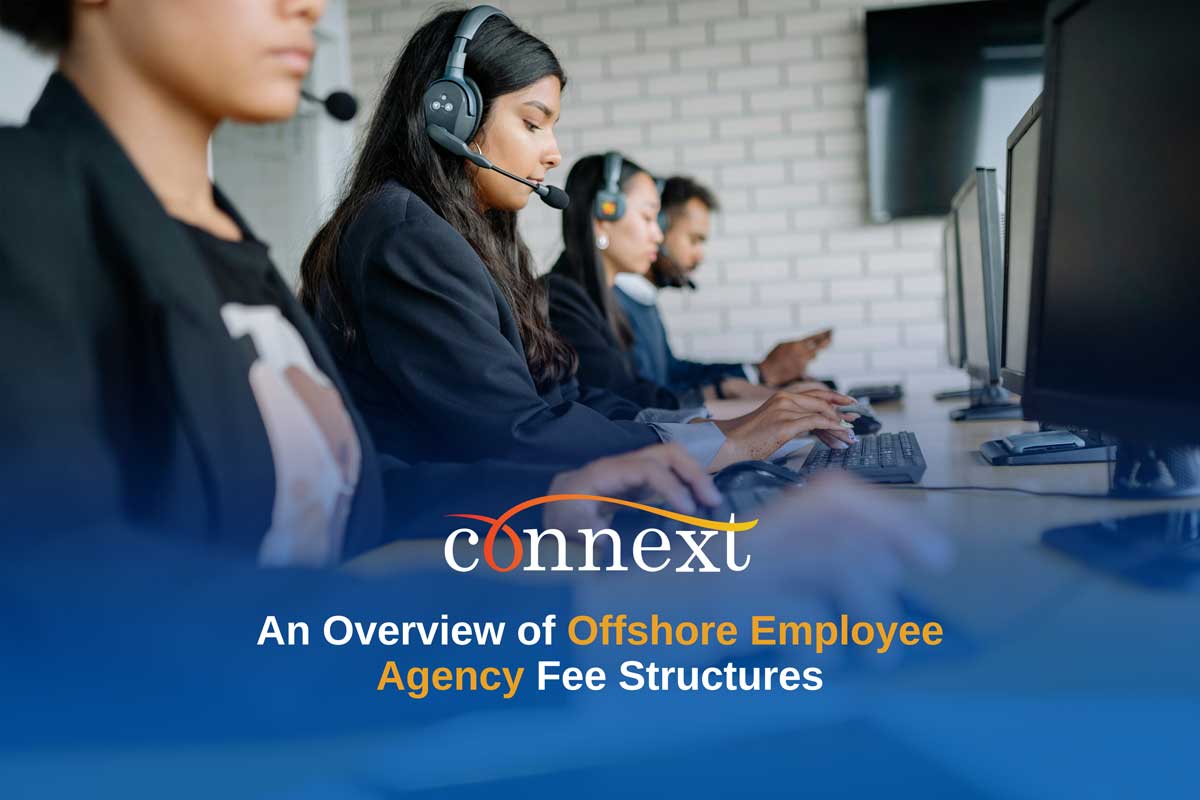Key Takeaways:
- Transparent fee models: Choose between flat-fee, percentage-based, or tiered pricing structures
- Upfront clarity: Understand all costs before signing—recruitment, onboarding, retention fees
- Service level considerations: Higher fees may include payroll, benefits management, and legal support
- Negotiation potential: Fee structures can be tailored based on volume, contract length, or role type
- Long-term savings: Despite upfront costs, offshore hiring often delivers substantial ROI
Offshore staffing can be a strategic solution for companies looking to scale effectively, access specialized talent, and reduce operational costs. When working with an offshore employee agency, understanding the fee structure is essential for budgeting and making an informed decision. The cost structure of offshore agencies can vary widely based on factors like the complexity of the roles, the level of support provided, and the geographic region of the offshore team.
Here’s an overview of the common fee structures used by offshore staffing agencies, along with the pros and cons of each approach.
1. Fixed Monthly Fee
In a fixed monthly fee structure, the client pays a set amount each month for each employee. This fee generally includes the employee’s salary, benefits, agency markup, and sometimes additional services like HR support or payroll processing. The fee is predictable, making it easy to budget for the year.
Pros: Simple, predictable pricing with no hidden costs; easy to budget for over time.
Cons: May not account for performance fluctuations; fixed cost might seem high if the agency’s fees are not transparent.
2. Cost-Plus Fee
The cost-plus model includes the employee’s salary and benefits, plus an additional percentage or fixed fee added by the agency to cover their management and overhead expenses. This structure provides transparency, as companies can see the direct costs of the employee, plus the agency’s markup.
Pros: Transparent breakdown of costs; typically includes detailed reporting on where funds are allocated.
Cons: Costs can vary depending on changes in employee salary or benefits; the additional fee may be higher for more specialized roles.
3. Hourly or Time-Based Rate
In the hourly or time-based rate model, companies pay based on the hours worked by each offshore employee. The rate typically includes employee wages, benefits, and agency fees.
Pros: Flexibility to scale hours up or down based on project needs; ideal for companies with fluctuating workloads.
Cons: Less predictability in budgeting; requires careful time tracking to ensure efficient use of resources.
4. Seat Leasing or Seat Fee
The seat leasing model, or “seat fee,” is common in offshore call centers or shared service environments. Companies pay a fee to “rent” a seat or workstation for each employee, which typically includes facilities, IT infrastructure, and sometimes basic administrative support.
Pros: Affordable for companies that only need minimal support beyond facilities; allows companies to manage employees directly.
Cons: Limited additional support; companies are often responsible for recruitment, training, and management of offshore staff.
5. Project-Based Fee
For short-term or project-based engagements, some agencies offer a fixed fee for the duration of the project. This model is common for IT, engineering, or consulting services, where the agency provides offshore talent to complete a specific project at a set price.
Pros: Fixed costs make it easy to budget for a one-time project; clear scope and deliverables.
Cons: Less flexibility if the project scope changes; may not be suitable for ongoing or long-term roles.
6. Bundled or All-Inclusive Fee
In a bundled or all-inclusive fee structure, the client pays one comprehensive fee that covers the employee’s salary, benefits, agency services, and often additional support such as IT, HR, and training. This fee structure simplifies billing by consolidating all costs into one monthly payment.
Pros: Full-service approach; companies do not need to manage individual expenses; high predictability.
Cons: May come with a higher agency markup; limited transparency on the breakdown of individual costs.
Factors That Impact Offshore Agency Fee Structures
- Role Complexity and Skill Level: Highly specialized roles, such as engineers or healthcare professionals, often come with higher fees due to the need for experienced and qualified candidates.
- Location of Offshore Team: Costs can vary significantly depending on the location of the offshore team. For example, fees for employees in the Philippines may differ from those in Latin America or Eastern Europe due to local wage standards.
- Level of Support Required: Agencies offering extensive support, such as HR management, training, IT infrastructure, and payroll, may charge higher fees compared to basic seat leasing or minimal service models.
- Team Size and Duration: Larger teams or long-term engagements often come with discounted rates. Some agencies may offer custom pricing for clients building a team of multiple employees or committing to a multi-year contract.
Choosing the Right Fee Structure for Your Business
Selecting the right offshore agency fee structure depends on several factors unique to your business:
Budget Constraints: If predictable costs are a priority, a fixed monthly or bundled fee may be the best option. If flexibility is more critical, consider a cost-plus or hourly rate model.
Duration of Engagement: For long-term or ongoing support, a fixed monthly or bundled fee structure provides stability. Project-based or time-based rates are often better suited for short-term or project-specific needs.
Level of Control: Companies that want full control over employee management may prefer a seat-leasing model, while those looking for full-service support might choose a bundled fee.
Transparency Needs: If transparency is a top priority, cost-plus pricing provides a clear breakdown of costs, so you know exactly how funds are allocated between employee salaries and agency fees.
Why Connext Global Solutions Offers Flexible Fee Structures for Offshore Staffing
At Connext Global Solutions, we understand that each business has unique staffing needs and budget constraints. That’s why we offer flexible fee structures, including fixed monthly, cost-plus, and bundled models, to ensure companies get the value and support they need at a price they can afford.
Connext provides:
Transparency in cost breakdowns and reporting, helping clients see where every dollar goes.
Scalability to adapt to changing needs, allowing companies to easily scale their offshore teams.
Custom Solutions tailored to client requirements, so you can choose the best fee structure based on your goals, budget, and level of support required.
With Connext, you’re not just gaining an offshore workforce; you’re partnering with a team dedicated to making offshore staffing work effectively and affordably for your business. Reach out to learn more about our fee structures and how we can build a custom solution that aligns with your growth objectives.
FAQ: Offshore Employee Agency Fee Structures
An offshore employee agency is a third-party service provider that helps businesses hire, onboard, and manage employees in another country—typically in cost-efficient labor markets. These agencies handle recruitment, payroll, HR compliance, and operational support for the offshore team.
Most agencies offer a replacement guarantee during the first 30–90 days if the hire is not a fit. However, refund policies vary. It’s important to confirm terms around employee attrition and trial periods before signing the contract.
Direct hiring may reduce costs on paper but comes with added risks and responsibilities—including managing local labor laws, payroll, HR disputes, and IT infrastructure. Agencies reduce these burdens by offering a compliant, turnkey solution with built-in support.
Connext offers transparent, scalable fee structures with no hidden charges. Our pricing includes employee compensation, compliance, administrative support, and infrastructure—tailored to meet your operational goals and budget. We work with your systems and workflows to provide flexible, high-quality offshore support.









